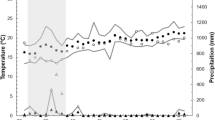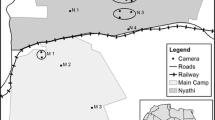Abstract
The reproductive value hypothesis predicts that the level of nest defence is determined by the expected chance of offspring to survive until reproduction, and by the reproductive potential of the parents. Rates of survival from one breeding season to the next are low in small passerines, and their residual reproductive potential strongly declines as the current breeding season terminates. Therefore, we can expect that parents which have only one breeding attempt per season should defend their nests more intensively than parents with a possibility to renest. We studied nest defence in populations of meadow pipit (Anthus pratensis) breeding in Norway and the Czech Republic, differing in renesting potential. To simulate the threat from a predator, we placed a stuffed stoat (Mustela erminea) first 5 m and then 1 m away from a nest with nestlings. Parents increased or kept nest defence constant when the stoat approached their nests in Norway and, during a breeding season shortened by severe weather, in the Czech Republic (when renesting potential was limited). Parents decreased nest defence when the stoat approached the nest during “normal” breeding seasons in the Czech Republic (when renesting was common). These findings give support to the reproductive value hypothesis.



Similar content being viewed by others
References
Aebischer NJ (1999) Multi-way comparisons and generalized linear models of nest success: extensions of the Mayfield method. Bird Study 46:22–31
Bahus TK (1993) Clutch size variation of the meadow pipit Anthus pratensis in relation to altitude and latitude. Fauna Norv Ser C Cinclus 16:37–40
Barash DP (1975) Evolutionary aspects of parental behavior: distraction behavior of alpine accentor. Wilson Bull 87:367–373
Brunton DH (1990) The effects of nesting stage, sex, and type of predator on parental defense by killdeer (Charadrius vociferous): testing models of avian parental defense. Behav Ecol Sociobiol 26:181–190
Burhans DE (2000) Avoiding the nest: responses of field sparrows to the threat of nest predation. Auk 117:803–806
Coleman RM (1987) Does experience with predators affect parental investment? Auk 104:791–792
Coulson JC (1956) Mortality and egg production of the meadow pipit with special reference to altitude. Bird Study 3:119–132
Cytel Software Corporation (2004) StatXact 6.2. Cytel Software Corporation, Cambridge
Ghalambor CK, Martin TE (2000) Parental investment strategies in two species of nuthatch vary with stage-specific predation risk and reproductive effort. Anim Behav 60:263–267
Gill SA, Grieef PM, Staib LM, Sealy SG (1997) Does nest defence deter or facilitate cowbird parasitism? A test of the nesting-cue hypothesis. Ethology 103:56–71
Griggio M, Matessi G, Pilastro A (2003) Male rock sparrow (Petronia petronia) nest defence correlates with female ornament size. Ethology 109:659–669
Halupka K (1998) Nest-site selection and nest predation in a passerine ground-nesters. Folia Zool 47:29–37
Halupka K, Halupka L (1997) The influence of reproductive season stage on nest defence by meadow pipits (Anthus pratensis). Ethol Ecol Evol 9:89–98
Hatch MI (1997) Variation in Song Sparrow nest defense: individual consistency and relationship to nest success. Condor 99:282–289
Hötker H (1982) Zum Verhalten junger Wiesenpieper (Anthus pratensis) nach der Nestlingszeit. Vogelwelt 103:1–16
Hötker H (1988) Lifetime reproductive output of male and female meadow pipits Anthus pratensis. J Anim Ecol 57:109–117
Hötker H (1989) Meadow pipit. In: Newton I (ed) Lifetime reproduction in birds. Academic, London, pp 119–133
King DI (1999) Mortality of an adult veery incurred during the defense of nestlings. Wilson Bull 111:576–577
Kleindorfer S, Fessl B, Hoi H (2003) The role of nest site cover for parental nest defence and fledging success in two Acrocephalus warblers. Avian Sci 3:21–29
Kleindorfer S, Fessl B, Hoi H (2005) Avian nest defence behaviour: assessment in relation to predator distance and type, and nest height. Anim Behav 69:307–313
Knight RL (1984) Responses of nesting ravens to people in areas of different human densities. Condor 86:345–346
Kruuk H (1964) Predators and anti-predator behaviour of the black-headed gull (Larus ridibundus L.). Behav Suppl 11:1–129
Manolis JC, Andersen DE, Cuthbert FJ (2000) Uncertain nest fates in songbird studies and variation in Mayfield estimation. Auk 117:615–626
Martin TE, Li P (1992) Life history traits of open- vs. cavity-nesting birds. Ecology 73:579–592
Montgomerie RD, Weatherhead PJ (1988) Risk and rewards of nest defence by parent birds. Q Rev Biol 63:167–187
Pavel V, Bureš S (2001) Offspring age and nest defence: test of the feedback hypothesis in the meadow pipit. Anim Behav 61:297–303
Pavel V, Bureš S, Weidinger K, Kovařík P (2000) Distraction displays in the meadow pipit (Anthus pratensis) females in Central and Northern Europe. Ethology 106:1007–1019
Redondo T (1989) Avian nest defence: theoretical models and evidence. Behaviour 111:161–195
Ricklefs RE (1969) An analysis of nesting mortality in birds. Smithson Contrib Zool 9:1–48
Rytkönen S, Soppela M (1995) Vicinity of sparrowhawk nest affects willow tit nest defence. Condor 97:1074–1078
Rytkönen S, Koivula K, Orell M (1990) Temporal increase in nest defence intensity of the willow tit (Parus montanus): parental investment or methodological artifact? Behav Ecol Sociobiol 27:283–286
Rytkönen S, Orell M, Koivula K (1995) Pseudo Concorde fallacy in the willow tit. Anim Behav 49:1017–1028
SAS Institute (2000) SAS OnlineDoc 8. SAS Institute, Cary
Sergio F, Bogliani GR (2001) Nest defense as parental care in the northern hobby (Falco subbuteo). Auk 118:1047–1052
Shields WM (1984) Barn swallow mobbing: self-defence, collateral kin defence, group defence or parental care? Anim Behav 32:132–148
Sproat TM, Ritchison G (1993) The nest defense behavior of eastern screech-owls: effects of nest stage, sex, nest type and predator location. Condor 95:288–296
Tryjanowski P, Golawski A (2004) Sex differences in nest defence by the red-backed shrike Lanius collurio: effects of offspring age, brood size, and stage of breeding season. J Ethol 22:13–16
Veen T, Richardson DS, Blaakmeer K, Komdeur J (2000) Experimental evidence for innate predator recognition in the seychelles warbler. Proc R Soc Lond B 267:2253–2258
Wiklund CG (1990) Offspring protection by merlin (Falco columbarius) females; the importance of brood size and expected offspring survival for defense of young. Behav Ecol Sociobiol 26:217–223
Yanes M, Suárez F (1997) Nest predation and reproductive traits in small passerines: a comparative approach. Acta Oecol 18:413–426
Zimmermann U, Curio E (1988) Two conflicting needs affecting predator mobbing by great tits (Parus major). Anim Behav 36:926–932
Acknowledgments
Authors are very grateful to Arne Moksnes and Eivin Røskaft for their help in arranging authors’ stay in Norway. They thank Bohumír Chutný, Petr Kovařík, Miroslav Král, Hana Olšovská and Petr Skřivan for assistance in the field. The authors also thank Jon Brommer, Konrad Halupka, Tereza Kumstátová, Adam Petrusek, Vladimír Remeš, Karel Weidinger and anonymous reviewers for helpful comments on the manuscript and David Hardekopf for improving the English of the paper. This work was supported by grants from the Grant Agency of the Czech Republic (GAČR 206/02/P074) and the Czech Ministry of Education (MSM-6198959212).
Author information
Authors and Affiliations
Corresponding author
About this article
Cite this article
Pavel, V., Bureš, S. Nest defence in the meadow pipit Anthus pratensis: the influence of renesting potential. J Ethol 26, 367–373 (2008). https://doi.org/10.1007/s10164-007-0075-7
Received:
Accepted:
Published:
Issue Date:
DOI: https://doi.org/10.1007/s10164-007-0075-7




